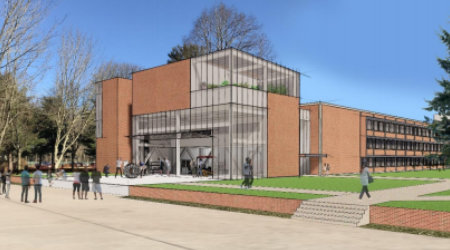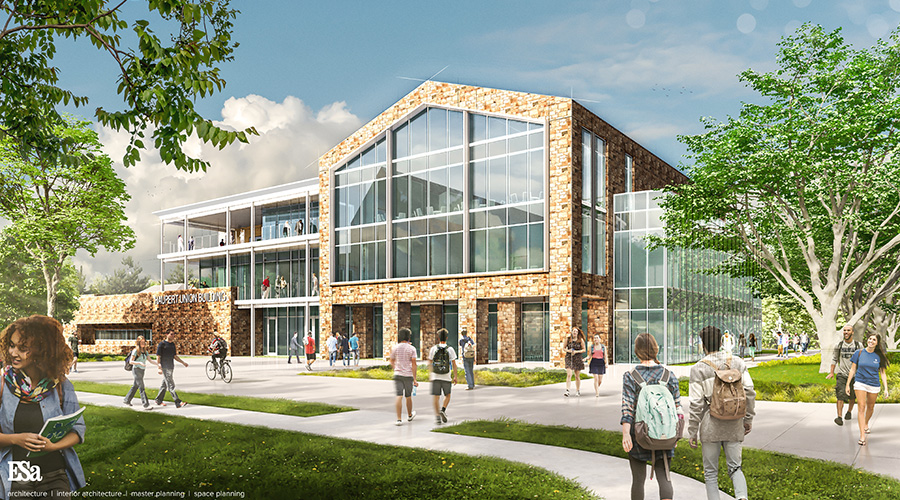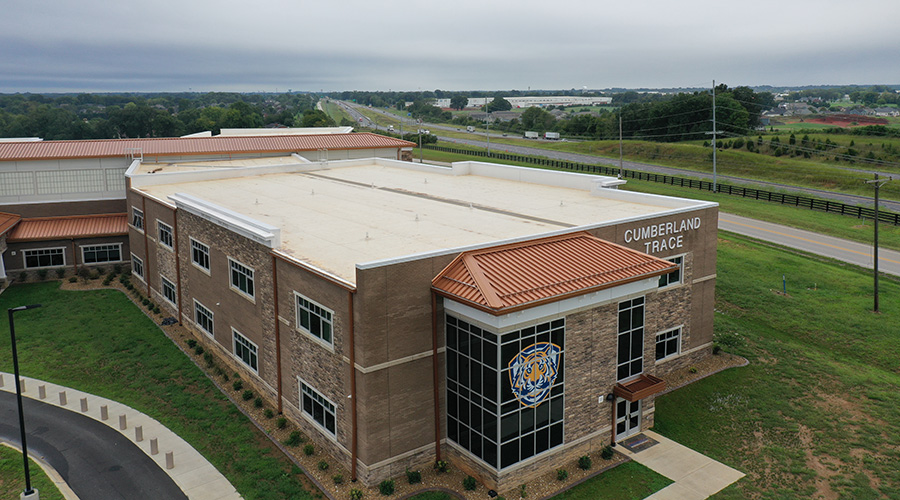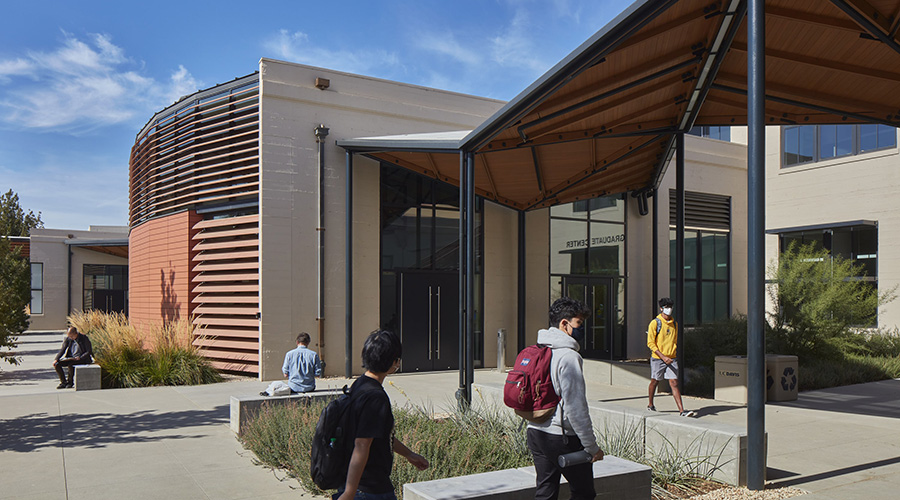 Maker Stage Concept Rendering
Maker Stage Concept RenderingRight On the Mark: Success in STEM Facility Design
To get the STEM facilities of the future right, consider these strategies to rate and score design.
Institutions of higher learning are facing many challenges in the coming decade. A demographic shift in the college-age population, constrained governmental funding, economic uncertainty from donor bases, and perhaps most traumatic of all, the life-altering impact of a worldwide pandemic all create conditions for what amounts to an existential crisis for some institutions. For several years, many colleges and universities have been looking for ways to remain competitive in anticipation of tighter budgets and a shrinking student body.
The challenges are not all negative. The rise of distance learning and ease of global communication have also impacted the ways in which academic institutions go about their business of education and research. The struggle to get the most value out of the investments these institutions make in the tools they use to deliver on their educational missions is as important as ever. One of the tools that requires significant investment is the learning environment itself: the campus, the building, the classroom. The question for many facility managers is how can your design team help you to achieve the best return on investment possible? One solution is that the design team can help by measuring the potential impact of a project before the investment is made.
The Best Value Schools platform uses publicly available data to create independent assessments of U.S. colleges and universities and then provides an objective resource for potential students and parents who are deciding what school to attend. In 2018, Best Value Schools published a report on the best modern college renovations and the impact these renovations had on the quality of the educational experience. Almost half of the projects on the list (14 out of 30) were science, technology, engineering, and math (STEM) renovations or STEM facilities, including the number one and two spots, and seven of the top 10.
The criteria used to determine “best” were several positive aspects cited repeatedly among those at the top of the list: Does it foster a sense of collaboration? Does it allow for multidisciplinary or interdisciplinary work? Does it accommodate innovative teaching and learning? Does it foster a sense of connectedness? Does it facilitate student access to faculty and specialized equipment? Does it have a high perceived level of prestige? When these human factors are addressed in the educational experience, the renovations are perceived to have high value.
Anything we can do to analyze or predict the success of the projects we undertake or calculate the return value for investment is a worthwhile exercise. We design spaces to educate people, but how does the human factor relate to that? How do people react physically, psychologically, and emotionally to a built environment? That is what we consider human factors to be, and these are the elements that most profoundly influence student, faculty, and community opinions of a particular learning environment.
Applying these criteria, we can identify five categories for a proposed human factor rating system: connectivity, multiplicity, accessibility, choice, and identity.
5 Human Design Factors
1. Connectivity is defined as spaces that support the creation of bridges between students and faculty to connect with each other as well as with outside corporate, industrial, and government partnerships. Connectivity has changed the way we work, specifically with STEM professions. Whether you are an engineer, a scientist, an analyst, or an economist, the paradigm in this century has shifted from a traditional solo learning model to a connected world. It is breaking down the barriers to information sharing and learning.
2. Multiplicity means providing multiple settings that foster different educational experiences and create spaces that can be easily adapted to different functions. It also means supporting multi-stage teaching approaches with classrooms and laboratory settings that flow from electronically based formats to hands-on workshop formats or lab work. Howard Gardner’s ground-breaking research on multiple intelligence theory in the early ’90s had a huge impact on the practice of education over the past 30 years. With that model he differentiates between eight different modes of human intelligence rather than considering them as one general ability. A recent study conducted by the University of Chicago worked to map out the modalities that different students respond to. The main conclusion of that study, and others like it, is that all students benefit from a variety of educational delivery methods. No one specific setting or teaching methodology is going to give you the optimal outcome. You need variety to achieve the best results.
3. Access. The Best Value Schools rankings also showed that many of the institutions with top-rated remodels invested in increased student access to faculty who are experts in their field, access to specialty tools, and access to specialized facilities where students can conduct their work. Access is what students are really looking for these days: access to a nurturing environment, other students, and people working in the broader field that they are pursuing.
4. Choice, according to research, is a significant human factor. This means giving educators and students choices in the types of spaces they use and accommodating the different ways educators teach. We enhance the sense of freedom faculty and students feel when they have a choice of spaces that are well designed for thinking, whether it is for individuals or small groups; spaces that accommodate the practicing of a skill, whether that’s a simulation environment or a makerspace; and spaces that allow for the communication and sharing of knowledge, whether that is between a faculty member and a class, an instructor and an individual student, or student to student. Again, it is about accommodating the different ways that students learn. It is really becoming a prerequisite for contemporary STEM facilities. The challenge is, how do you find the right menu of those types of spaces when you are in the pre-planning, programming, and design process?
5. Institutional Identity is one of the most nebulous human factors from a design standpoint, but it is a significant element when it comes to the perception of educational value. It is important for universities to develop a brand identity and associate that identity with their STEM facilities, so students can carry that identity into the future. This matters for academic STEM environments, because corporations and government agencies associate value with where you received your education. It also helps foster alumni support in the years to come.
Scoring Space Types
When it comes to applying the point-based rating scale to different academic environments, certain space types stand
out more than others for meeting human factor needs. At the top of this list are student spaces, makerspaces, active learning spaces, and practical simulation spaces.
Informal student spaces outside of the classroom or laboratory have really become prominent in the last couple of decades. What we are seeing now is that colleges and universities are dedicating an average of between 7 to 15 percent of the net assignable square footage to informal spaces that are extensions of the learning environment. This indicates that they add value when it comes to connecting people. It is also easy to create multiple types of settings on various scales with this type of space, whether it is individual spaces or large open areas that accommodate large functions. They offer a lot of freedom for people to come plug in and have a cup of coffee, connect with members of the community, and spend a good portion of their day between classes. That sense of freedom and choice adds a lot of value. Because these spaces also tend to be at the entrance to a STEM facility or at the front door of a campus, they offer institutions the opportunity to build their brand image and foster that sense of connectedness. For those reasons, student spaces score very highly in terms of human factor values.
Team-based active learning spaces, simulation spaces, and makerspaces also score highly because they provide different choices in learning modalities, access to specialized equipment and people, broad connectivity, and an elevated sense of identity. Team-based learning environments are probably the most important space type of the last 40 years. Makerspaces have also captured the imagination more than any other campus space in recent years. So, they score a five out of five on the human factor scale.
Applying Human Value to the Index
The question is, how can designers and facility owners develop a practical way to measure the human factor of different spaces in a way that informs decision-making and validates return on investment for renovation and construction projects? One idea is to approach the subject in the same way facility owners use the facility condition index (FCI) to determine whether a building should be built or renovated based on the relative costs of needed maintenance and modernization upgrades versus the cost of replacement.
The Facility Condition Index (FCI) as a tool was first published in 1991 by the National Association of College and University Business Officers (NACUBO). It is used in facilities management to provide a benchmark to compare the relative condition of a facility. The FCI is primarily used by a facility manager or third-party assessment professional to support asset management initiatives. A Facility Condition Assessment is performed and then factored in relation to the monetary value the organization places on the facility. Accurate measure of condition and value are necessary.
Mathematically the FCI is represented as: FCI = Maintenance, Repair, and Replacement Deficiencies / Current Replacement Value of the Facility.
When the FCI is greater than 0.10, it suggests a classification of poor and that replacement of the facility is considered appropriate. While the FCI is a relative indicator of the physical condition of a building, academic institutions today can benefit from determining an index of measurement that also factors the institution’s educational and research mission and strategic goals beyond the physical condition of a building and it’s infrastructure. Human Factors, the intangible aspects of the educational environment, perhaps carry more weight in the assessment of a facility’s ability to carry out the educational and/or research mission.
Applying a combined index approach, a Facility Value Index (FVI), can help owners determine what space types warrant investment and how to prioritize limited funding to attract more students and improve outcomes. When we are looking at the question of renovating or replacing an existing facility, we can go into each of those spaces and look at how well they achieve these human factors. If a facility is 30 years old, it is probably not going to satisfy many of those factors. Relatively modest spaces may be noticeable in terms of human factor value they provide. We can rate spaces across campus on a scale that can be inserted into the index with a consensus on how much weight the human factor will carry. As architects,it can be a very powerful tool to inform the decision-making process and help our client plan and achieve success. As a Facility Planner and Manager, risk can be mitigated and outcomes improved.
Jay Hallinan, senior laboratory planner for FCA, has decades of experience in designing state of the art facilities for corporate, academic, and healthcare clients.
Related Topics:












